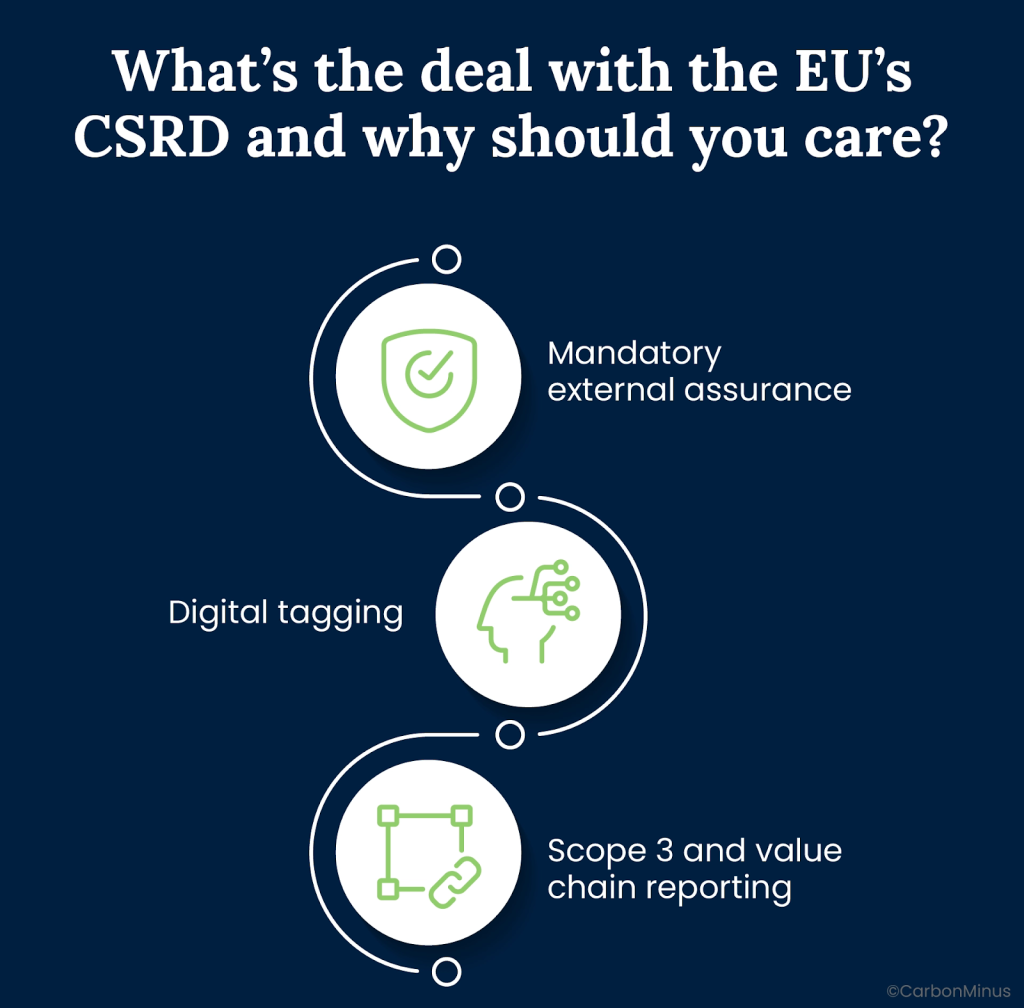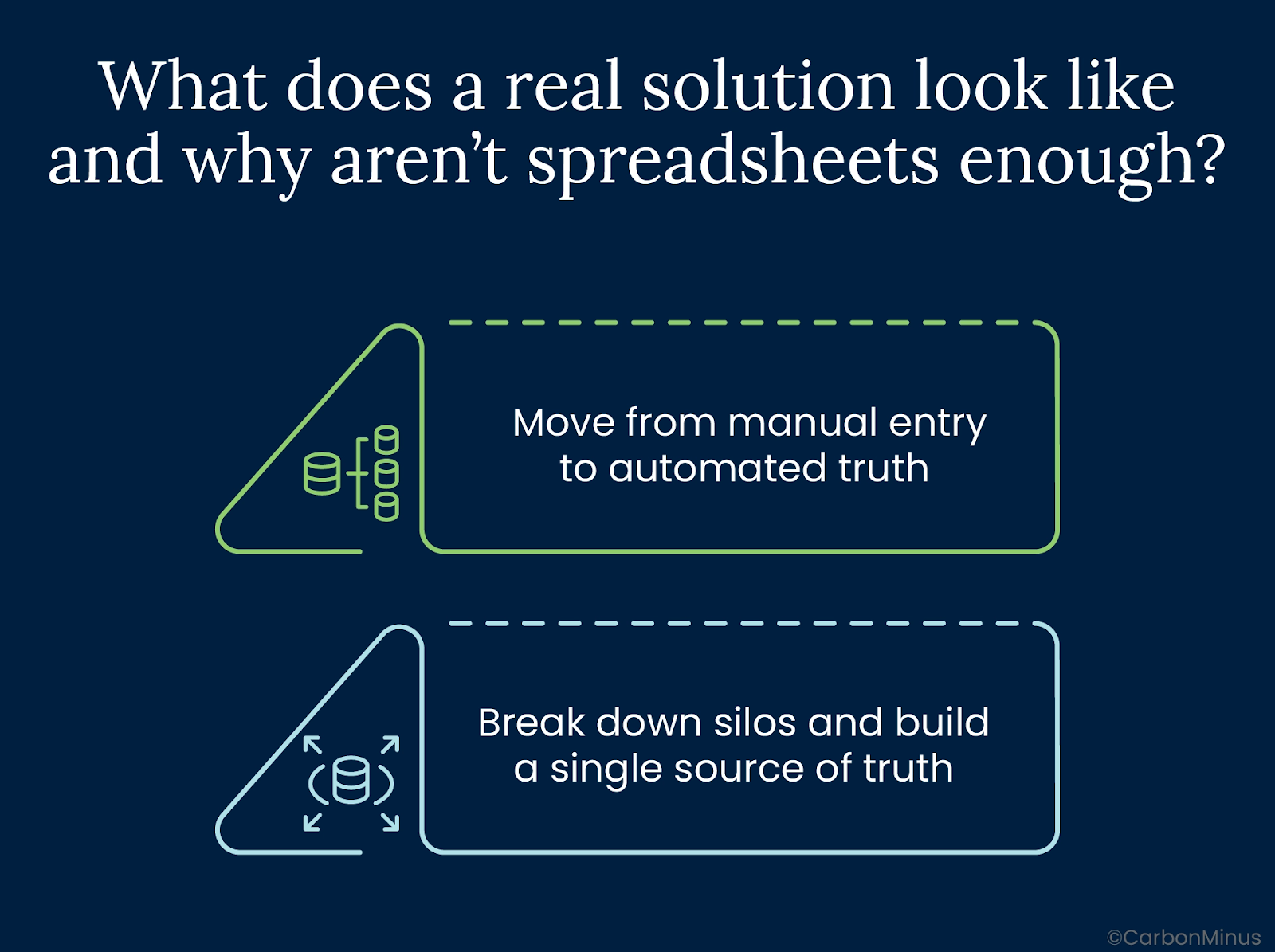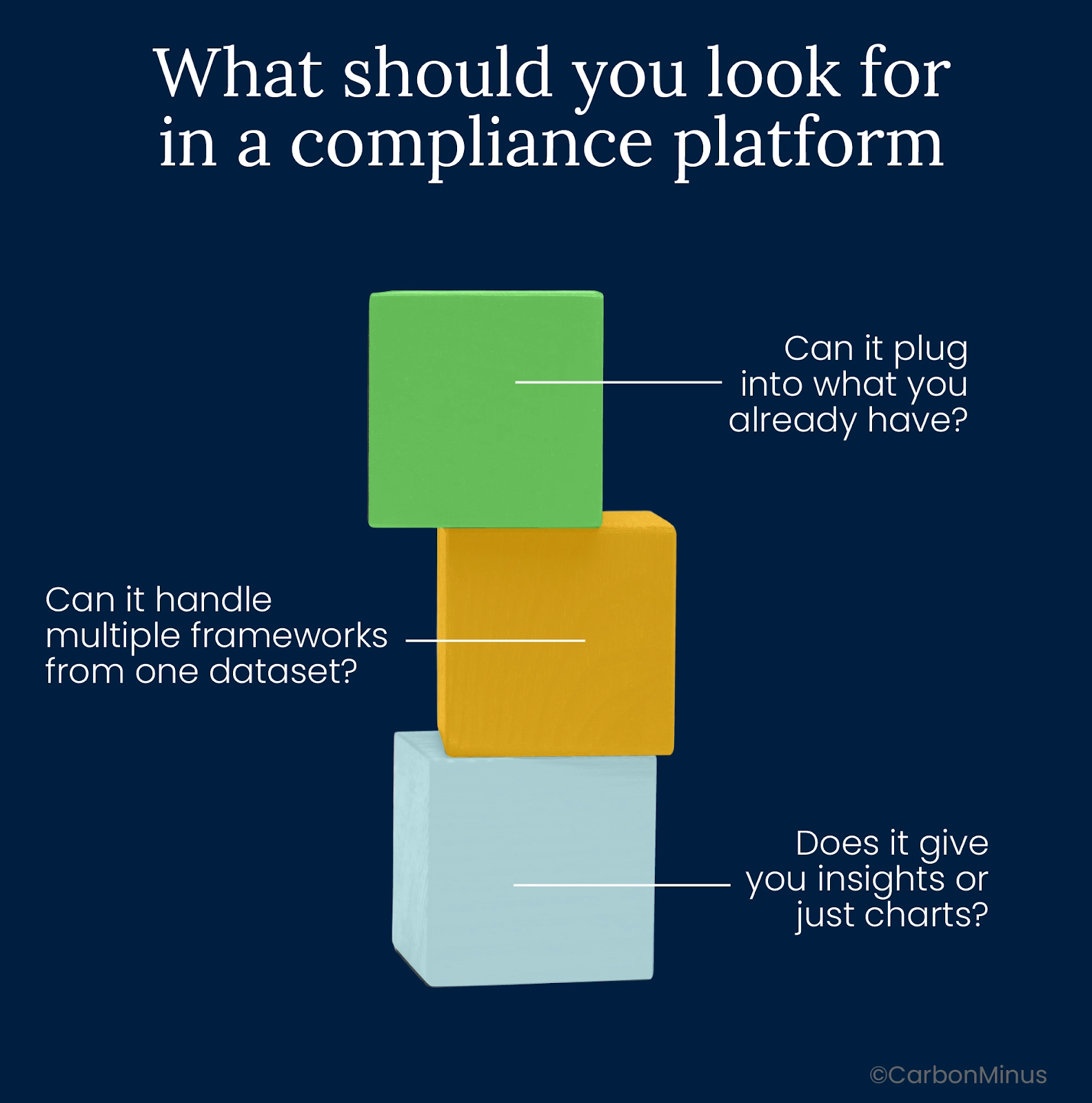Key Takeaways
- Manual compliance is now a liability.
- CSRD, GEI, and SEC rules demand audit-ready data.
- IoT and centralized platforms provide real-time accuracy.
- Unified systems enable multi-standard reporting at scale.
- Strategic compliance builds resilience and protects margins.
Running a global company today feels a bit like flying a single jet across three different airspaces while each region rewrites the rules mid-flight. One demands you drop altitude. Another says climb. The third wants you to repaint the plane.
That’s climate compliance in 2025.
You’ve got one brand. One sustainability target. But you’re forced to juggle a tangle of evolving, conflicting regulations.
What the EU mandates under CSRD doesn’t line up with India’s GEI targets. The SEC can’t decide whether it’s in or out. And your teams are stuck wrestling spreadsheets like it’s 2009.
More than a reporting headache, this is an operational risk. Not to mention a financial liability. And if you’re not treating it like critical infrastructure, you’re already behind.
In this post, we’ll walk through the three regulatory shifts that matter most right now and why trying to manage them manually is a gamble you can’t afford. More importantly, we’ll show you what the right kind of tech infrastructure looks like.
One that turns compliance chaos into strategic control.
By the way, if you’re already under pressure to justify ROI, run your numbers here. It’s a fast way to see the upside of getting this right.
Let’s get into it.
So what’s driving all this?
You’re probably wondering where exactly is all this pressure coming from? What should I actually be paying attention to right now?
Let’s break it down. Here are the three regulatory forces creating the most noise and why none of them can be ignored.
What’s the deal with the EU’s CSRD and why should you care?
The Corporate Sustainability Reporting Directive (CSRD) is the EU’s way of saying that they are done with vague promises. Now, they want to see the data.
It applies to over 50,000 companies. Not just in Europe. If you’re a non-EU firm with significant revenue in the region, you’re on the hook too.

But it’s not just the scope that matters. It’s the standard. CSRD brings three mandates that punch a hole through legacy compliance processes:
- Mandatory external assurance. That means your numbers can’t just “look good”. They have to hold up under audit.
- Digital tagging. Reports must be machine-readable, not buried in PDFs.
- Scope 3 and value chain reporting. Yes, you’re now responsible for emissions from your suppliers, vendors, and partners.
Old systems weren’t built for this. Spreadsheets won’t cut it. And if you’re still chasing data across business units at quarter-end, CSRD will eat you alive.
What’s happening in India and why is it suddenly hitting the P&L?
Here’s what’s new: India’s moving from nice-to-have pledges to hard performance targets. The Greenhouse Gas Emissions Intensity (GEI) mandate sets actual emissions benchmarks by sector.
But here’s the kicker. It’s no longer just compliance, it’s now cash.
Enter the Carbon Credit Trading Scheme (CCTS). If you beat your GEI targets, you earn credits.
You can sell them. Bank them. Turn them into strategic assets.
Falling short? You’ve got to buy credits to cover the gap with real money.
This turns climate performance into a line item. From ESG it becomes EBITDA. And it’s changing how CFOs look at energy, operations, and sustainability across Indian facilities.
The SEC rule is paused so why is the US still a risk?
Technically, yes, the SEC’s climate disclosure rule is on pause. But let’s not get comfortable.
Legal stays don’t erase momentum. They delay it. Every signal from regulators and investors is that disclosure’s coming, one way or another.
Whether it’s the SEC, California’s laws, or private equity ESG mandates, the pressure’s still there.
The real risk? Betting that inaction buys you time. Because if you’re not building agile systems now, you’ll be scrambling when the next rule drops.
In the U.S., the rules always come fast and with teeth.
What does a real solution look like and why aren’t spreadsheets enough?
At this point, it’s obvious: manual processes won’t survive what’s coming.
They’re brittle. Slow. Prone to human error.
And worst of all? They give you a false sense of control.
So what does a real solution look like?
Think of it like this. If your compliance system were an actual building, most companies are still operating out of a wooden shack.
What you need is reinforced steel. A digital foundation strong enough to withstand global scrutiny, but flexible enough to adapt as rules shift.
Here’s what that foundation looks like in practice.

How Do You Move from Manual Entry to Automated Truth?
Start at the source of your data. Not the reports, but the raw signals.
IoT sensors are your front line here. Installed across facilities, they capture energy use, fuel flow, water consumption, and process emissions automatically. No more chasing paper logs or miskeyed Excel cells. The data is real-time, timestamped, and audit-ready by default.
That’s your first upgrade: truth you don’t have to question.
Because it’s automated, you can scale it across borders. One factory or fifty, it doesn’t matter.
The inputs stay clean, and your team isn’t stuck doing data janitorial work.
How do you break down silos and build a single source of truth?
Raw data’s just step one. The real power kicks in when you unify it.
A centralized platform pulls in all that IoT data and integrates it with your existing systems like ERP, SCADA, EMS, you name it.
Procurement meets operations. Sustainability meets finance. Everyone works from the same map.
No more version control nightmares. No more bouncing between teams to reconcile mismatched reports.
You’ve got one platform, one dashboard, one shared view of your environmental footprint.
This is what lets you go from reactive to strategic. From last-minute compliance reporting to proactive decision-making.
What should you look for in a compliance platform and what’s non-negotiable?
Let’s say you’re sold on the idea and you know manual systems won’t cut it.
You know you need tech. But the real question is: what kind?
There’s no shortage of dashboards out there promising to “streamline sustainability.” But most are just polished reporting tools glued onto brittle infrastructure.
You need more than that. You need a system built for this exact moment for fragmented regulations, global operations, and real financial stakes.
Here’s what to demand:

Can it plug into what you already have?
This one’s critical. If a vendor tells you to rip out your existing sensors or install their proprietary gear just to get started, walk away.
A modern platform should be hardware-agnostic. It should connect to what’s already installed such as your meters, your PLCs, your cloud systems and unify that data without breaking what works.
That means faster rollouts, lower costs, and no disruption to daily ops.
The tech should serve your business, not the other way around.
Can it handle multiple frameworks from one dataset?
This is where the right platform goes from a nice tool to a strategic weapon.
You shouldn’t need five systems to report to five regulators. A best-in-class solution ingests the data once and spits out audit-ready reports for CSRD, GEI Rules, ISO 14064, BRSR whatever the rulebook demands.
That’s agility. It means you’re prepared when regulations shift, when new markets open, when stakeholders ask tough questions.
This is what lets you scale without spinning up a new team every time the rules change.
Does it give you insights or just charts?
Reports are table stakes. What you really want is foresight.
A modern compliance platform should come with built-in analytics that do more than track emissions.
They must show you where to cut waste, how to optimize resources, and where the next risk might hit.
We are talking about —
- Live dashboards.
- Predictive alerts.
- Performance benchmarking.
Compliance shouldn’t be the end goal. It should be a byproduct of running your operations smarter.
How do you turn compliance chaos into resilience?
Here’s the bottom line: the patchwork of climate regulation isn’t going away. It’s getting more tangled, more aggressive, and more expensive to ignore.
In order to win companies will have to be the ones reacting fast. They’ll be the ones that build resilience into the system with infrastructure that’s unified, automated, and built to flex with whatever’s next.
That’s what this is really about. While compliance is a necessity, the bigger goal is protecting your license to operate by preserving margins and moving from ESG lip service to operational truth.
Ready to build your compliance infrastructure?
If this hit close to home, here’s what to do next:
Run your numbers through the CarbonMinus ROI calculator. It’s a quick, practical way to see what smart compliance infrastructure could save (and earn you).
Want to skip the calculator and get straight to brass tacks? Book a no-pressure consultation and let’s look at how this works for your business, your tech stack, your footprint.
The business sustainability landscape’s not getting simpler. But your playbook can.
Let’s make sure you’re on the right side of this shift.
FAQs
We’re already doing sustainability reports. Isn’t that enough?
Not anymore. Today’s regulations like CSRD in the EU or the GEI in India aren’t asking for glossy PDFs or estimated numbers. They require:
- Audit-grade data.
- External assurance.
- Digital tagging.
- Scope 3 traceability.
What passed last year won’t fly this year. The bar just got raised.
What’s so different about the CSRD?
Three things:
- External audits of your ESG data gets the same scrutiny as your financials.
- Digital formatting with no more burying info in a 200-page PDF.
- Scope 3 requirements for you now own your value chain’s emissions.
It’s the most aggressive ESG regulation we’ve seen and it applies to non-EU firms too if they meet the revenue threshold.
What’s happening in India, and why does it hit the bottom line?
India’s new GEI targets link emissions performance to the Carbon Credit Trading Scheme (CCTS). Exceed your target? You earn credits with tradable assets. Miss it? You have to buy credits to make up the gap. This will have a direct impact on your margins.
The SEC rule is on hold, why should we still act?
Because “on hold” doesn’t mean “going away.” Investor pressure, state-level rules (like California), and voluntary frameworks are already driving expectations. If you wait for the final ruling, you’ll be too late. Compliance infrastructure takes time and regulators don’t care if you’re not ready.
Why won’t spreadsheets cut it anymore?
Because they were never designed for what’s being asked now. You need real-time, machine-generated data that’s consistent, auditable, and easy to report across frameworks. Spreadsheets are slow, error-prone, and impossible to scale globally. They create more risk than they solve.
What should I look for in a compliance platform?
Three non-negotiables:
- Hardware-agnostic integration: It should work with the systems and sensors you already have.
- Multi-framework reporting: One dataset, multiple regulatory outputs.
- Operational intelligence: Not just reports, but insights that help you reduce emissions and cut costs in real time.
How do I know this is worth the investment?
That’s the easiest part. Run your numbers. The CarbonMinus ROI calculator will show you based on your industry and annual energy bill how much you can save. This will help you use the money to generate more value.




